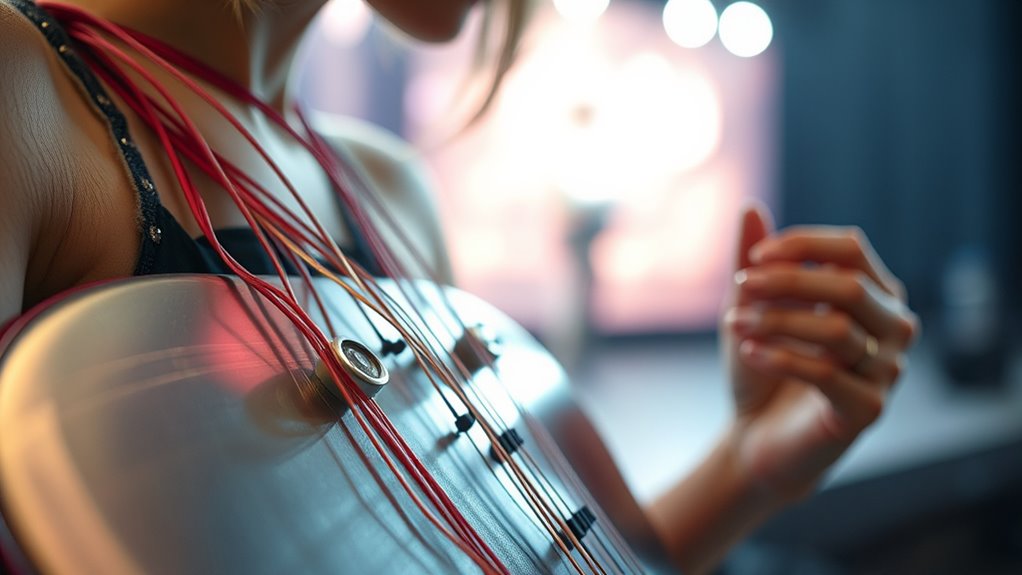Wearable instruments transform your body movements into sound, making music creation more intuitive and immersive. With gesture control, you can conduct or produce melodies using simple wrist flicks and hand waves, replacing traditional instruments. These devices offer tactile feedback, enhancing your musical experience by resonating with the notes you play. Suitable for all skill levels, they simplify creation and foster confidence. There’s a whole world of innovation waiting for you to explore.
Key Takeaways
- Wearable instruments transform body movements into sound, creating innovative interfaces for musical expression.
- Gesture control allows users to conduct music through natural movements, enhancing creativity and accessibility.
- Tactile feedback provides engaging sensations, deepening the connection between the performer and the music.
- These instruments accommodate all skill levels, simplifying the learning process and encouraging improvisation.
- The future of music technology lies in wearable instruments, promoting dynamic and personal musical experiences.

Have you ever wondered how technology can enhance your musical experience? Imagine strapping on a device that transforms your body movements into captivating sounds. Wearable instruments are revolutionizing the way you engage with music, providing new interfaces that allow for a more intuitive and immersive experience. These innovative tools are designed to respond to your gestures, empowering you to create music in ways you never thought possible.
With gesture control, you literally conduct your symphony with the flick of a wrist or the wave of a hand. Instead of relying solely on traditional instruments, you can harness the power of your movements to produce sound. For instance, wearing a smart glove can enable you to strum, tap, or press invisible notes in the air, translating your physical actions into mesmerizing melodies. This interaction not only adds a layer of creativity but also breaks down the barriers for those who may feel intimidated by conventional music-making methods.
The tactile feedback from these devices further enriches your experience. When you wear an instrument that provides tangible sensations, it creates a deeper connection between you and the music. You’ll feel the vibrations as you play, making the experience more engaging and visceral. Imagine strumming a virtual guitar and feeling a pulse that resonates with each note. This physical response encourages you to explore and express your musical ideas more freely, allowing you to experiment with various styles and techniques without any constraints.
Moreover, wearable instruments can be incredibly versatile. Whether you’re a seasoned musician or a complete beginner, these devices adapt to your skill level, providing a platform for growth and discovery. You’ll find that the learning curve is less steep, as the technology guides you along the way. As you become more comfortable with gesture control and the tactile feedback, your confidence grows, and you might even find yourself improvising on the spot. Additionally, the integration of high refresh rates in wearable instruments can enhance the responsiveness of your movements, ensuring an even more seamless musical experience.
The world of music is evolving, and wearable instruments are at the forefront of this transformation. By integrating gesture control and tactile feedback, they offer a unique, hands-on approach to musical expression. So, why not plunge into this new universe of creativity? Embrace the technology and discover how it can elevate your musical journey, making it more dynamic and personal than ever before. After all, music is meant to be experienced, and with wearable instruments, you’re set to transform your passion into something extraordinary.
Frequently Asked Questions
How Do Wearable Instruments Enhance Traditional Musical Performances?
Wearable instruments enhance traditional musical performances by introducing gesture control and haptic feedback. You can express yourself more freely, as your movements directly influence the music, creating a dynamic connection between you and your audience. With haptic feedback, you feel the rhythm and intensity of your performance, making it more immersive. These innovations allow you to explore new musical dimensions, engaging both you and your listeners in a fresh, interactive experience.
Can Wearable Instruments Be Used in Live Collaborations?
Absolutely, you can use wearable instruments in live collaborations! They enhance remote collaboration by allowing musicians to connect and perform together, regardless of distance. With these instruments, you can create dynamic interactions that engage the audience, making them feel part of the experience. Imagine the excitement as you and your collaborators explore new sounds in real-time, all while the audience responds to the energy and creativity you’re bringing to the performance.
What Types of Sensors Are Commonly Used in Wearable Instruments?
Imagine a futuristic symphony where your movements create sound. In that world, common sensor types like accelerometers, gyroscopes, and pressure sensors play pivotal roles in data acquisition. Accelerometers detect your speed and direction, while gyroscopes measure orientation. Pressure sensors capture touch intensity, transforming your gestures into musical expressions. So, as you wear these instruments, you’re not just participating; you’re composing a unique experience that resonates with every movement you make.
Are There Any Notable Artists Using Wearable Instruments?
Yes, there are several notable artists using wearable instruments. You might find artist collaborations like those involving Imogen Heap, who blends technology and music in innovative performance art. Heap’s musical gloves allow her to create sounds through gestures, transforming the way audiences experience her performances. Other artists, like the group Kaki King, also explore wearable tech to enhance their live shows, pushing the boundaries of creativity and audience interaction.
How Do I Choose a Wearable Instrument for Beginners?
When choosing a wearable instrument for beginners, look for options that prioritize beginner accessibility and user-friendly designs. Check if they utilize sensor technology for intuitive interaction, allowing you to easily create music. Consider devices with clear tutorials and supportive communities to help you learn. Lightweight, comfortable instruments with a variety of sounds can enhance your experience. Don’t hesitate to experiment with different types until you find the one that resonates with you!
Conclusion
Wearable instruments are revolutionizing how you express yourself musically, allowing for seamless integration into your daily life. Imagine this: research shows that musicians using wearables can increase their performance engagement by up to 60%. With these innovative tools, you can transform everyday movement into mesmerizing sounds, turning every step into a beat and every gesture into a melody. Embrace this new frontier of musical expression and let your creativity flow through your body like never before!










